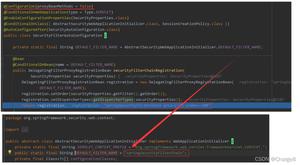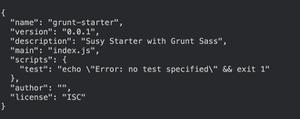Spring AOP在pointcut expression解析表达式 并匹配多个条件
本文内容纲要:Spring AOP在pointcut expression解析表达式 并匹配多个条件
Pointcut 方法是那些需要运行"AOP",由"Pointcut Expression"为了描述叙事.
Pointcut以下方法可以通过定义任&& || 和!组合方式.
args()
@args()
execution()
this()
target()
@target()
within()
@within()
@annotation
当中execution 是用的最多的,其格式为:
execution(modifiers-pattern? ret-type-pattern declaring-type-pattern? name-pattern(param-pattern)throws-pattern?
)
returning type pattern,name pattern, and parameters pattern是必须的.
ret-type-pattern:能够为*表示不论什么返回值,全路径的类名等.
name-pattern:指定方法名,*代表所以,set*,代表以set开头的全部方法.
parameters pattern:指定方法參数(声明的类型),(..)代表全部參数,(*)代表一个參数,(*,String)代表第一个參数为不论什么值,第二个为String类型.
举例说明:
随意公共方法的运行:
execution(public * *(..))
不论什么一个以“set”開始的方法的运行:
execution(* set*(..))
AccountService 接口的随意方法的运行:
execution(* com.xyz.service.AccountService.*(..))
定义在service包里的随意方法的运行:
execution(* com.xyz.service.*.*(..))
定义在service包和全部子包里的随意类的随意方法的运行:
execution(* com.xyz.service..*.*(..))
定义在pointcutexp包和全部子包里的JoinPointObjP2类的随意方法的运行:
execution(* com.test.spring.aop.pointcutexp..JoinPointObjP2.*(..))")
***> 最靠近(..)的为方法名,靠近.*(..))的为类名或者接口名,如上例的JoinPointObjP2.*(..))
aop:config <aop:pointcut expression="execution(* com.travelsky.ccboy.dao..*.find*(..))|| execution(* com.travelsky.ccboy.dao..*.query*(..))" id="findCachePointcut" /> <aop:advisor advice-ref="jdbcInterceptor" pointcut-ref="findCachePointcut" /> </aop:config> 在多个表达式之间使用 ||,or表示 或,使用 &&,and表示 与,! 表示 非. 上面的代码也能够改写成 aop:config <aop:pointcut expression="(execution(* com.travelsky.ccboy.dao..*.find*(..))) or(execution(* com.travelsky.ccboy.dao..*.query*(..)))" id="findCachePointcut" /> <aop:advisor advice-ref="jdbcInterceptor" pointcut-ref="findCachePointcut" /> </aop:config> 注意上面两中方法的不同点出了 将 || 改成了 or ,还有就是 每一个execution都被()包括起来,建议为了区分不同的表达式 最好都是用()包装。
pointcutexp包里的随意类.
within(com.test.spring.aop.pointcutexp.*)
pointcutexp包和全部子包里的随意类.
within(com.test.spring.aop.pointcutexp..*)
实现了Intf接口的全部类,假设Intf不是接口,限定Intf单个类.
this(com.test.spring.aop.pointcutexp.Intf)
***> 当一个实现了接口的类被AOP的时候,用getBean方法必须cast为接口类型,不能为该类的类型.
带有@Transactional标注的全部类的随意方法.
@within(org.springframework.transaction.annotation.Transactional)
@target(org.springframework.transaction.annotation.Transactional)
带有@Transactional标注的随意方法.
@annotation(org.springframework.transaction.annotation.Transactional)
***> @within和@target针对类的注解,@annotation是针对方法的注解
參数带有@Transactional标注的方法.
@args(org.springframework.transaction.annotation.Transactional)
參数为String类型(执行是决定)的方法.
args(String)
Pointcut 能够通过Java注解和XML两种方式配置,例如以下所看到的:
<bean id="bravemandao" class="com.test.dao.BraveManDao"> <property name="barveman" ref="braveman"></property>
</bean>
<bean id="braveman" class="com.test.bean.BraveMan">
</bean>
<bean id="minstrel" class="com.test.bean.Minstrel"></bean>
<aop:config>
<aop:aspect ref="minstrel">
<aop:pointcut expression="execution(* *.test(..))" id="say"/>
<aop:before pointcut-ref="say" method="singBeforeSay"/>
<aop:after pointcut-ref="say" method="singAfterSay"/>
</aop:aspect>
</aop:config>
package com.test.bean;
public class Minstrel {
public void singBeforeSay(){
System.out.println("before say!!!");
}
public void singAfterSay(){
System.out.println("after say!!!");
}
}
public class BraveManDao {
BraveMan braveman;
public BraveMan getBarveman() {
return braveman;
}
public void setBarveman(BraveMan braveman) {
this.braveman = braveman;
}
public void test(){
braveman.say();
}
}
版权声明:本文博客原创文章。博客,未经同意,不得转载。
本文内容总结:Spring AOP在pointcut expression解析表达式 并匹配多个条件
原文链接:https://www.cnblogs.com/mfrbuaa/p/4664177.html
以上是 Spring AOP在pointcut expression解析表达式 并匹配多个条件 的全部内容, 来源链接: utcz.com/z/362879.html







